Topic: Color Studies
| Color Studies |
Color Studies - Melrose Avenue, Wednesday, December 6, 2006



| « | December 2006 | » | ||||
| S | M | T | W | T | F | S |
| 1 | 2 | |||||
| 3 | 4 | 5 | 6 | 7 | 8 | 9 |
| 10 | 11 | 12 | 13 | 14 | 15 | 16 |
| 17 | 18 | 19 | 20 | 21 | 22 | 23 |
| 24 | 25 | 26 | 27 | 28 | 29 | 30 |
| 31 | ||||||

| Color Studies |



| Off to Bayonne |
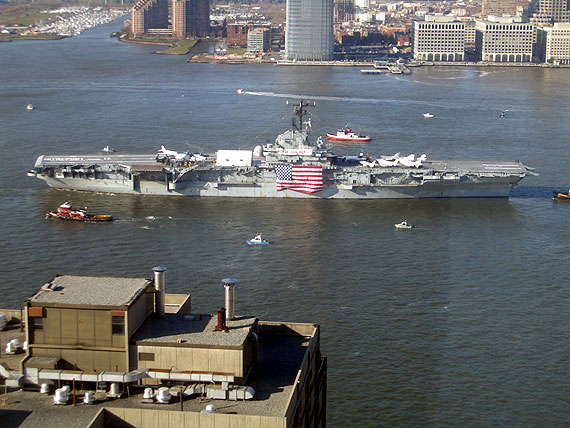
The Associated Press explanation -
Shrink-wrapped vintage warplanes? Cool.A month after a failed attempt to move the USS Intrepid, the historic aircraft carrier was finally freed Tuesday from the Hudson River anchorage where it had sat for nearly a quarter of a century as a museum.
"This old baby is moving," a joyous Intrepid Foundation President Bill White said aboard the vessel. Some crew members cried and gave each other high-fives and hugs. Onlookers ashore cheered.
"It's like it used to be, only better. There's no bloodshed," said elated passenger Felix Novelli, who served on the Intrepid crew during World War II. "I'm 18 again. And I have my beautiful broad right here, my ship Intrepid."
As the Intrepid passed the World Trade Center site, about 20 former crew members unfurled a 50-feet by 90-feet American flag and stood in a silent salute.
The trip began with considerable effort, the historic aircraft carrier-turned-museum inched haltingly away from its anchorage. Finally, it began moving at about 3 to 4 knots, its pier growing more and more distant.
"Move baby, move baby!" the crew and passengers yelled. Then, "We did it, we did it!"
In the previous attempt, thick mud had proved too strong for six "tractor tugs" exerting some 30,000 horsepower. Another battle occurred this time, too - the blue water was churned dark brown as tugboats strained to budge the giant vessel from its longtime home.
"If she doesn't move, we are going to jump in and push her," a former crew member, 84-year-old Joe Cobert, said on the Intrepid's deck before the behemoth began to move on Tuesday.
Asked later if he was glad he didn't have to push the ship, Cobert said, "We did push. All the crew members. How do you think we got out of there?"
Recalling his years on the ship, Cobert said, "It brings back memories. It was always thrilling when we were under way. We'd yell to everyone onshore, 'See Ya when we get back.'"
The smaller boats moved the ship stern first into the center of the Hudson River, then nudged the bow until it was parallel with the shore and began heading downstream.
The carrier was being towed, still backward, down the river toward New York Harbor for a five-mile trip to a shipyard in Bayonne, N.J., where it will undergo renovations.
A Fire Department boat sailed alongside the Intrepid, shooting red, white and blue colored water from its hoses. River traffic resumed after being halted while the ship was pulling away from the pier.
Three weeks of dredging removed nearly 40,000 cubic yards of muck from under the ship and around its four giant screws. Based on an assessment by military engineers and tugboat operators, officials had said they expected a smooth departure for the 64-year-old World War II hero ship.
In the first attempt on Nov. 6, the 36,000-ton carrier moved only a few feet before the propellers dug into the bottom, the tide dropped, and the mission was scrubbed.
The second effort seemed almost like a stealth version of the first, without the ceremonial trappings. Instead of VIPs, only officials, journalists and ex-crew members were on deck.
"I don't know how moving an aircraft carrier around in New York could ever be low-key, but we had the celebratory event the first time and we are not having that again," White said earlier.
The Intrepid survived five Japanese kamikaze suicide plane attacks and lost 270 crew members in the last two years of the Pacific war. It later served off Korea and Vietnam and as a recovery ship for NASA astronauts.
Decommissioned in the late 1970s, it was destined for the salvage yard when rescued by New York developer Zachary Fisher and transformed into a floating military and space museum that opened in 1982, recently drawing upward of 700,000 visitors a year.
Intrepid officials said the $60 million overhaul, lasting up to two years, would include stem-to-stern "refurbishment and renovation" to repair deterioration and open up long-closed areas to the public. The ship's exhibits were put in storage and most of its 20-plus vintage warplanes shrink-wrapped for protection during the hiatus.
Photograph Copyright © 2006 - M. A. Hewitt, all rights reserved
| The Noble Savage at the Electric Fountain |
 On the northwest corner of Wilshire and Santa Monica Boulevards there's the Beverly Hilton Hotel, from 1955 and now all remodeled, with Trader Vic’s attached (the place that invented the Mai Tai and other girly drinks with the little paper parasols, and still offers that taste of the fifties, an Americanized version of what Polynesian food might be like if you never left Iowa and made it all up). On the southwest corner, across from a Starbucks that used to be leather shop where you could get a suede bomber jacket, there's Creative Artists Agency (CAA) - a big white whale of a building by Richard Meier, that fellow who did The Getty Center. It's full of major Hollywood agents, of course. On the southeast corner is the parking lot of the Beverly Hills Budget Rent-a-Car folks. Yes, you can rent a Rolls or Ferrari or Lamborghini out here. They’re all lined up there.
On the northwest corner of Wilshire and Santa Monica Boulevards there's the Beverly Hilton Hotel, from 1955 and now all remodeled, with Trader Vic’s attached (the place that invented the Mai Tai and other girly drinks with the little paper parasols, and still offers that taste of the fifties, an Americanized version of what Polynesian food might be like if you never left Iowa and made it all up). On the southwest corner, across from a Starbucks that used to be leather shop where you could get a suede bomber jacket, there's Creative Artists Agency (CAA) - a big white whale of a building by Richard Meier, that fellow who did The Getty Center. It's full of major Hollywood agents, of course. On the southeast corner is the parking lot of the Beverly Hills Budget Rent-a-Car folks. Yes, you can rent a Rolls or Ferrari or Lamborghini out here. They’re all lined up there. It is still rather spectacular.Electric fountain is said to have stopped traffic for hours when unveiled in 1931 (quoted in "Fountain Blues", New West, April 25, 1977). Originally, the Fountain's water jets and color effects were timed to give 60 different combinations every 8 minutes. Total cost of the Fountain was $22,000, $8,000 of which was spent for electrical equipment and wiring (from "Request for Determination of Eligibility for Inclusion in the National Register of Historic Places," prepared by Lois M. Webb and George Casen, p.2. also see Jennifer Ring, "Splash and Spray Around LA; A Tour of Some of the City's Classier Spouts," Westways, September 1972).
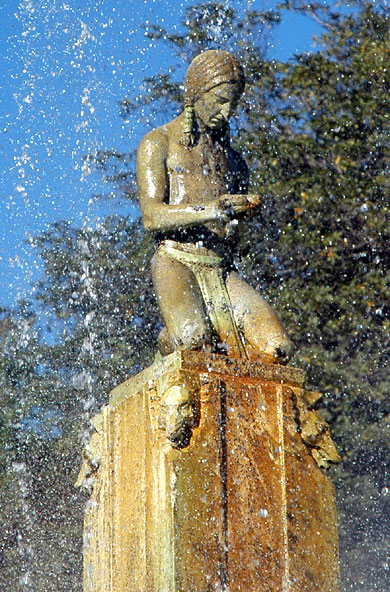 Then there's Robert Merrell Gage -
Then there's Robert Merrell Gage - Gutzom Borglum, the man who carved the famous figures on Mount Rushmore, called Robert Merrell Gage "that steady-eyed young sculptor," and from those steady eyes came a vision of art that spoke of strong values, American values, Kansan values. An alumni of the most sophisticated art schools, Robert Merrell Gage turned for subject matter to the basics of American history, the stories of the western struggle and the lives of heroes of the American soul.
Gage was a native Topekan, born in 1892, and educated in the Topeka public schools and at Washburn College. He left Kansas after graduation to study sculpture in both New York and France with Borglum and Robert Henri, two exponents of the "American Theme" in art. Returning to Topeka in 1916, the young sculptor set up shop in a barn behind his house on Fillmore Street and began his first public commission, the magnificent statue of Lincoln that rests on the Kansas State Capitol grounds. After a stint in the armed services during World War I, Gage began a teaching career at Washburn and at the Kansas City Art Institute. In 1924, Gage left the Midwest for a position at the University of Southern California, a post he held until his retirement in 1958.
The winner of many awards and honors, Robert Merrell Gage left behind a large and excellent body of work when he died in 1981. His interests were many and they were reflected in the materials he worked with-stone, wood, metal, and clay-as well as his format, which ranged from portraiture to architectural sculpture. But his subjects consistently expressed major American themes. Among his better known works are his "Pioneer Mother Memorial" situated a short distance from his Lincoln statue at the Kansas State Capitol, his busts of Walt Whitman and John Brown at the Mulvane Art Museum, his "Police Memorial" and "Veterans' Fountain" in Kansas City, and his "History of California" frieze in Beverly Hills.
Deeply impressed by the writings of Walt Whitman and the example of Abraham Lincoln, Gage portrayed and interpreted the freedom and dignity of the American experience through the medium of his art. Some have called him, and, indeed he was, "the American sculptor."
Native Americans may be offended now by the patronizing and imperialistic tone of much here, but this was 1931, and the benign American myth of exactly what had happened was still strong.
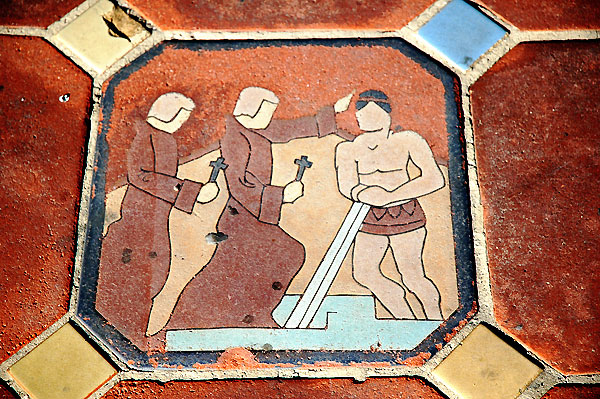
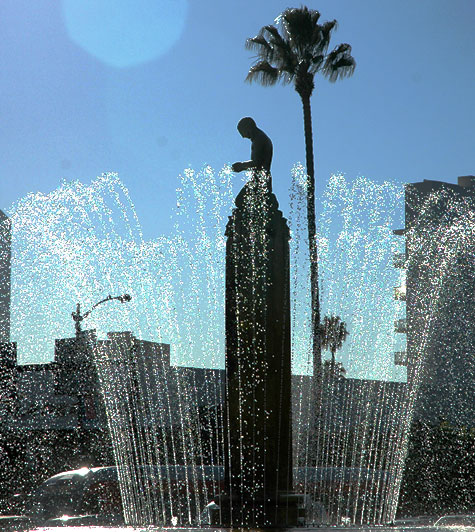

| Christmas Stars |
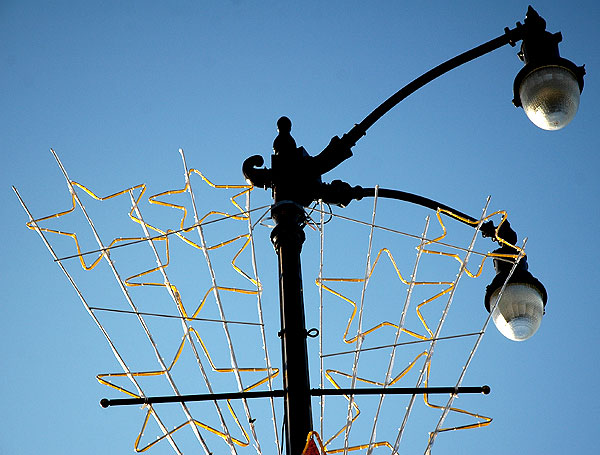
Feeling a little negative about Christmas?
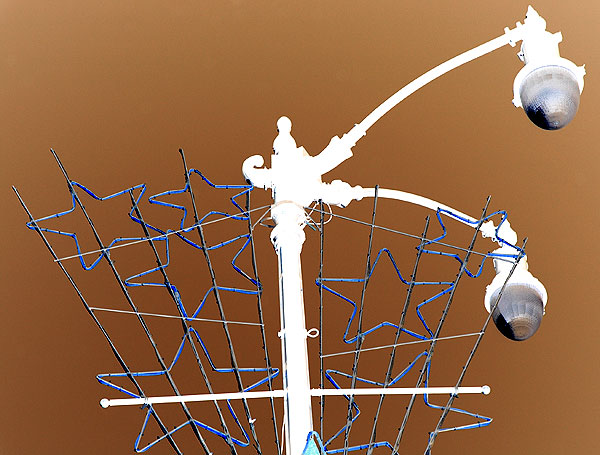
| Santa as Voyeur |


Bijan, at 420 Rodeo Drive, is the single most expensive store in the world. You must make an appointment in advance to shop at Bijan (which was named after its Iranian owner). On a typical visit, Bijan's average customer spends about a hundred grand on men's fashions, which range from fifty dollar pairs of socks to the fifteen thousand dollars suits.
Suzy Menkes in the International Herald Tribune on 27 November says Rodeo Drive is so last decade. The important center of fashion is now Melrose Place - "The intimacy of Melrose Place compares to the bustling, youth-oriented Robertson Boulevard, a five-minute drive away, and the glossy plate glass and palm trees of Rodeo Drive (which has chandeliers as its Christmas lights)." She quotes Bill Blass when he found an old house on Melrose Place he could buy - "I had my eyes on Melrose Place for four years and then this house came up. I think it is very chic and I am in love with this space. It is going to be the most important street in fashion. Rodeo Drive is for tourists." Blass' place opened last month. Note that Melrose Place is just around the corner from Trashy Lingerie.
This is an odd town.